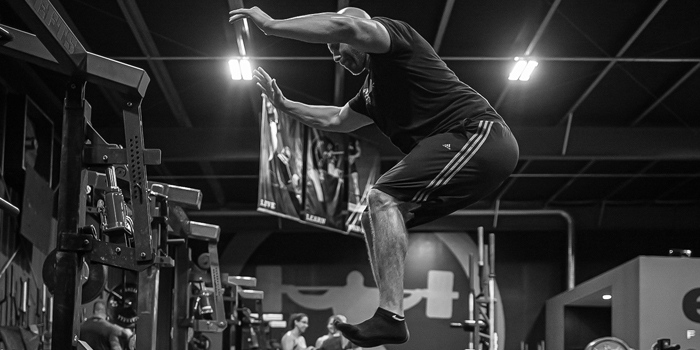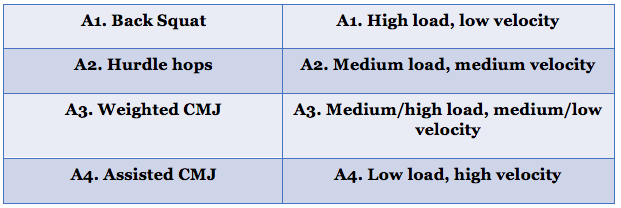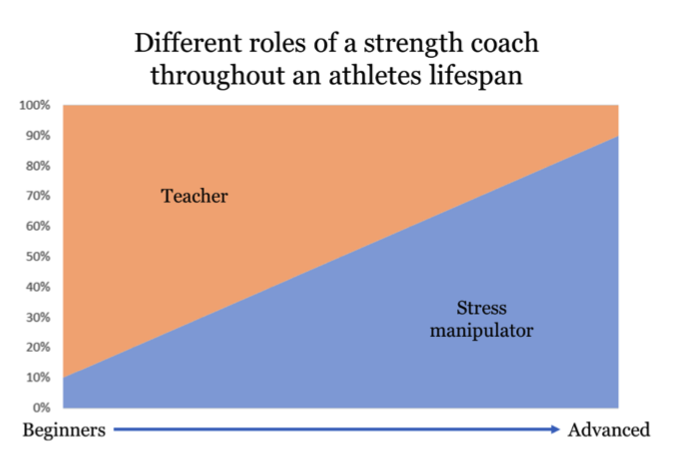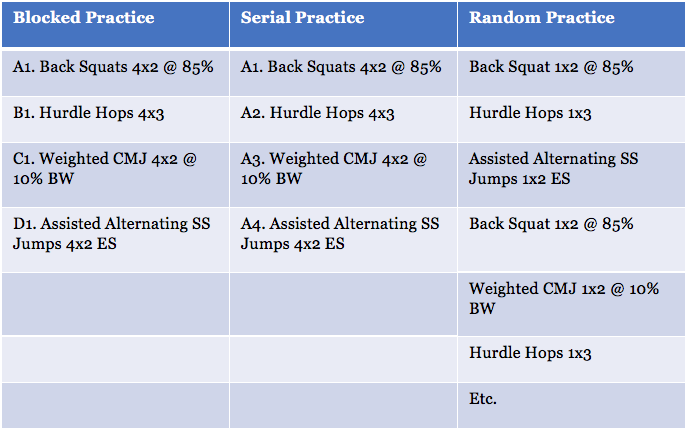
This article is inspired by a Twitter post that caused a fair amount of discussion. A practitioner posted that they commonly use the French Contrast Method for beginners and that they have seen great improvements in their athletes (read more about it in the book Triphasic Training).
This is peculiar because the French Contrast Method is an advanced loading strategy that traditional thoughts would indicate is more suitable for advanced practitioners. However, I intend to present an argument for why components of the French Contrast Method MAY be suitable in some situations for beginners.
RELATED: Don't Be Afraid to Try
To begin, let’s explore the French Contrast Method and the underlying principles involved in its traditional application. The French Contrast Method is a series of four exercises, performed in quick succession, designed to combine both contrast and complex training strategies to elicit a potentiation response.
Essentially, an athlete performs a heavy loaded exercise followed by a plyometric exercise, followed by a weighted plyometric exercise, and finally, an accelerated/low load plyometric. All of these exercises are performed with low repetitions in the one to three range.
In practice, it looks something like Table 1, with the exercise selection being somewhat less important (so long as they are still similar across the set and somewhat sports specific) than the load velocity characteristics of the movement. For those that want to nit-pick, high and low velocity are just relative to the other exercises in this complex, not to the vast array of human movements.

The underlying physiological mechanism that is theorised to make this set structure effective is that of potentiation. Potentiation is a phenomenon that occurs when a conditioning exercise, commonly a heavy loaded compound movement, serves to increase the performance of a subsequent exercise, commonly a lower load, higher velocity exercise.
The mechanisms for which potentiation may facilitate an increase in performance are:
- Increased phosphorylation of the myosin regulatory light chain;
- Increased Type II motor unit recruitment; and
- Reduced muscle fibre pennation angle (Sale DG, 2002).
To go into more detail than this is beyond the scope of this article.
Now here is where we hit a snag when using this with beginners.
Let’s briefly list some of the potential issues of using a French Contrast Method with beginners:
- It requires use of high intensity weighted exercises, which the beginner may potentially not be able to perform safely (although a halfway intelligent practitioner could get around this with an alternative exercise selection).
- It creates a high-stress environment. In Triphasic Training, the French Contrast Method is said to produce “enormous amounts of stress.”If you are a practitioner that adheres to a minimum effective dose or even just someone searching for optimal dose, using a strategy that is (anecdotally) said to induce a large stress response in advanced athletes may be overkill and/or potentially dangerous for beginners.
- The biggest kicker really is that largely athletes have to have a degree of strength to be able to efficiently utilise the potentiation effect (Seitz and Haff, 2016). For me, this is because muscular coordination at the beginning stages of strength development is infinitely more important than some physiology trickery in inducing an optimal training effect. This does, however, lead me to the reasoning for why the French Contrast Method (or an adapted version of it) may cause a positive training response in junior athletes.
It is fairly well established that for the first six to eight weeks of a training program (for beginners), the primary improvements seen will be due to motor learning as opposed to specific local changes such as increased muscle CSA (Haff and Triplett, 2015). I would, however, go further than this and espouse that the primary goal of the initial stages (0-2 years) in resistance training is primarily motor learning.
Traditional strength training guidelines are somewhat warped for beginners, and I believe that we can achieve good physiological changes whilst focusing on the motor learning components of movement. To put this simply and to stick with the philosophies of Cal Dietz, as strength coaches, we could be seen as primarily stress and rest manipulators. I would contend that with novice athletes, we are not stress manipulators (although there is still an element of this), but rather we are simply teachers. Really, I would also argue that with advanced athletes, we are still teachers; however, the manipulation of stress plays a greater part. Something like this.

The thing is, not a large percentage of athletes in field sports will ever reach an advanced stage in strength training, and therefore, the importance of teaching should not be underestimated.
But I digress. The point here is that perhaps with beginners we need to be looking at motor learning literature rather than strength training literature to give us clues as to how to best train our athletes. One concept that relates to this is the organisation of practice. Here there are three primary ways to organise training: block, serial or random practice.
Blocked practice is pretty simple. It is a conventional way of organising training. It is the continuous learning of a single skill at a time. It is a decent method for stark beginners (Landin and Hebert, 1997). They need to devote a large amount of time and attention to a single skill, and it needs to be heavily coached. This is because a serial or random organisation of training may affect the consolidation of learning (Neville and Trempe, 2017).
Serial training is where skills are performed in a sequence (think circuit-style training).
Then random training is, as the name suggests, random.
The figure below can explain this more clearly, utilising the four movements we previously used as an example of French Contrast Training (although motor learning concepts can be applied to all facets of the weight room).
The serial and random patterns of organising practice work due to contextual interference, where essentially the training structure causes more attention to need to be paid to the task at hand (Abbas Afsanepurak et al., 2012). We can surely all relate. You do one thing for an extended block, and you lose focus.

As you can see, the serial approach to the organisation of practice actually looks somewhat like the French Contrast Method. It made up of four exercises, performed one after another under minimal fatigue due to the low repetitions with a serial pattern of organisation.
Theoretically, for those that have already consolidated the movement patterns to some extent, this structure of training may be advantageous for learning.
However, there are some adaptations to the traditional model of the French Contrast Method that may be pertinent to training beginners. The first has already been discussed. The exercises used should not be novel to the participants. Further, the traditional intensity percentages as described in Triphasic Training are perhaps less appropriate for beginners. Again, remember, this book was written with an eye toward stress manipulation as opposed to motor learning.
Therefore, conventionally I would recommend for beginners a large decrease in the percentage recommendations (or even using RPE in the 6-7/10 range) and a slight increase in the repetition guidelines (but not enough to make the athletes fatigued).
Ultimately, this post was inspired by people jumping down the throat of a fella on Twitter. At its core, I agree with the premise that the French Contrast Method as it was traditionally written is inappropriate for beginners. However, I have simply shed some light on one of the factors that I believe may cause the method to be effective in athletes of all levels, bar the extreme novice.
With a few slight adjustments, you now have a training program that not only targets a number of physical capacities but also adheres to a key principle of motor learning. Further, I hope I have somewhat illustrated that of the many factors that a practitioner should take into account when planning a training session, an often overlooked but incredibly important facet is to create an environment optimal for learning.
References
- Abbas Afsanepurak S, Karimiyani N, Moradi J, et al. (2012) The Effect of Blocked, Random, and Systematically Increasing Practice on learning of Different Types of Basketball Passes. European Journal of Experimental Biology 2: 2397-2402.
- Dietz, C., and Peterson, B. (2012) Triphasic Training: A systematic approach to elite speed and explosive strength performance (Vol. 1). Dietz Sport Enterprise.
- Haff GG and Triplett NT. (2015) Essentials of strength training and conditioning 4th edition: Human kinetics.
- Landin D and Hebert EP. (1997) A Comparison of Three Practice Schedules along the Contextual Interference Continuum. Research Quarterly for Exercise and Sport 68: 357-361.
- Neville K-M and Trempe M. (2017) Serial practice impairs motor skill consolidation. Experimental Brain Research 235: 2601-2613.
- Sale DG. (2002) Postactivation potentiation: Role in human performance. Exercise and Sport Sciences Reviews 30: 138-143.
- Seitz LB and Haff GG. (2016) Factors modulating post-activation potentiation of jump, sprint, throw, and upper-body ballistic performances: A systematic review with meta-analysis. Sports Medicine 46: 231-240.
Charles Dudley is a performance coach currently based out of Beijing, China, who's working for the Chinese Olympic Committee. He has previously worked privately as a strength and conditioning coach for a number of sports such as rugby union, tennis, and hockey, in addition to coaching a number of national-level weightlifters. Charlies has also been a tactical coach in rugby union and rugby 7s at the schoolboy and academy/elite pathway levels.











2 Comments